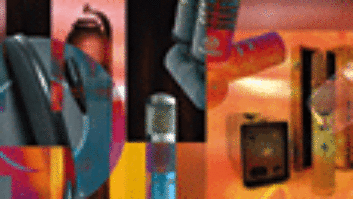
London, UK (May 15, 2019)—Four years after the release of their seventh studio album, 2015’s Everything Ever Written, Scottish indie rock cult heroes Idlewild are back with album number eight: Interview Music. Co-produced by the band’s guitarist Rod Jones and intermittent producer and collaborator Dave Eringa, Interview Music was conceived in LA back in 2017 while the band was touring the U.S. and finalized in Edinburgh at Jones’s own recording facility, Post Electric Studio.
Here, Jones tells PSNEurope editor Daniel Gumble what it was like to team up once again with Eringa, discussing the role of the producer and the stark contrast between their eighth record and anything they’ve done before…
Dave Eringa features once again as a producer on the new album. Tell us about your relationship with him…
We had started the record in Los Angeles while on tour and then carried on in Edinburgh at my studio (Post Electric Studio) with myself at the controls, but after almost two years we still hadn’t finished the album and needed a catalyst to push us forward. We’ve worked as a band and on solo work with Dave on and off throughout our careers; he has a great understanding of how we work and how to get the best out of us as musicians. So, we decided to record five additional songs with him to try and reinvigorate the record. This really pushed us on to finish the other songs. Dave has always been a mentor to me since I started to produce and I still feel I always learn so much from him every time we work together. It made total sense after this to have him mix the whole album, both the songs he had recorded and the ones we had done ourselves.
How heavily involved were you in the production process of the record?
On the ‘non Eringa’ sessions I was at the helm/controls, although as a band we were very collaborative in terms of sonics and imaging the recordings. With Dave, although we all still weighed in, we were much more keen to let him lead.
Was there a specific sonic identity you were looking for for this album?
We all have such vast ranging idea about sonics and all of us almost pre-produced our own sounds for our instruments, so for me, it was about trying to create a psychedelic space that facilitated such contrasts to work together. Allowing sonic clashes to compliment and merge without sounding confused or mismatched. It was really about sounding free and fearless.
How closely did you collaborate with Dave Eringa in the studio?
We have always had an open dialogue with Dave (I personally speak to him most weeks as a friend and mentor) so we know how to work together well. We would discuss almost every sonic decision and although we don’t always all agree, we all trust Dave so much he would almost always win! I guess that’s one of the biggest reasons we got him on board for those five songs. Not just to produce but to moderate and guide all of our sprawling ideas and opinions. That’s the sign of a great producer I think. Someone you can trust to guide you through all those decisions and curate all the ideas and differences to make something coherent and exciting, rather than convoluted. It was yet another inspirational session with him for me.
What does Idlewild look for in a producer?
I think for us it’s a mediator and almost a sixth band member who can collaborate and sort through ideas and contrasts. Someone whose opinion we trust to be able to take the best bits from everyone’s differences and knit them together. There is a way that Idlewild sounds when Dave works with us, certainly, and that’s something to do with the way he pulls certain things out of each of us.
How did the recording/production process of this record compare with the last one?
It was really different in that the last record was made with people joining mid process and was much more fragmented in recording, so I had taken much more control of it. Also, I was still learning my trade then – although I’m always learning, as all producers are. This time was much more a band working together and sharing ideas from the get go. This in itself had challenges with the curating of ideas and making everyone’s voices heard. Without the Dave session, it may have ended up very convoluted but he snapped us back into focus, giving us the momentum to finish the other songs and center the record.
Where did you make the album?
We started at Kingsize Sound Labs in Eagle Rock, LA on our US tour and recorded, or at least started, six songs before moving on to my studio in Leith, Edinburgh. Here we recorded the rest of the album, some ourselves and five songs with Dave.
Can you tell us a little bit about the studio?
Myself and my friend Kris Pohl took over the studio (formerly Tape Studio) in autumn 2016 and renamed it Post Electric Studio. The band rehearses and records there, but we are also a commercial studio. It was built by our “landlady” and owner Fiona Bryant around five years prior to us taking over. The live room is Munro Acoustics designed and we have a well-curated selection of analogue outboard to complete our SSL Duality 48 channel console, and of course all our amps, pedals, guitars and gear we’ve collected over the years. Currently, we are running Kii mini mains and Amphion One_15s for monitoring. We also have a couple of mix suites and creative offices as a sort of music hub with mixers, labels, music managers, a music festival and a youth music initiative in the building. It feels very much like a community and collaborative space where we try to make bands and artists feel as welcome and relaxed as possible so they are free to be creative.






